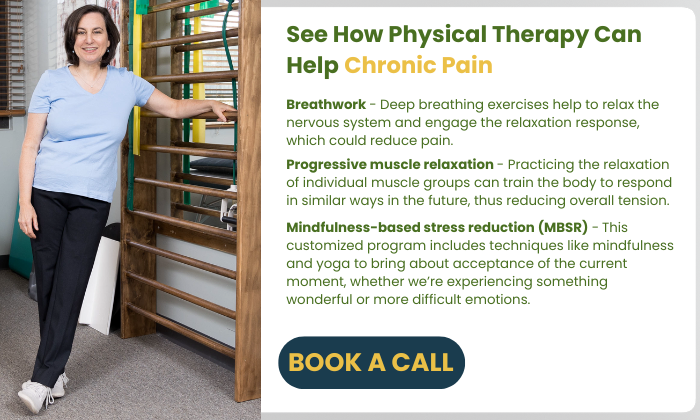Chronic pain has become an epidemic—according to Healthline, as of 2021, 50 million Americans are living with the condition. This amounts to nearly 20 percent of the U.S. population. To continue our education on chronic pain, we became inspired by one of the latest episodes of Mayim Bialik’s podcast, Mayim Bialik’s Breakdown. The episode features guest Alan Gordon, founder of the Pain Psychology Center and author of The Way Out: A Revolutionary, Scientifically Proven Approach to Healing Chronic Pain. Alan and Mayim delve into the neuroscientific explanation of chronic pain, so we wanted to share more information around this topic, too.
How do we define chronic pain?
Chronic pain can be distressing and debilitating, affecting not only our physical health, but our mental and emotional health too as it disturbs our feelings of safety and security. Chronic pain occurs when localized or centralized pain afflicts the body for at least three to six months. At its core, chronic pain is a central nervous system disorder. As referenced by Alan Gordon, chronic pain can occur when an injury has healed or an illness has subsided, yet the brain still interprets signs of danger and triggers pain.
Due to the many ways chronic pain can present itself within the body, it can be hard to pinpoint the root cause and find lasting healing. The physical therapists at The Manual Touch have extensive experience working with patients experiencing chronic pain using non-traditional and traditional manual therapies while guiding their patients through a personalized exercise program so as not to flare up their pain.
In recent decades, and especially in recent years, a focus on the brain and our responses to stimuli has been a key research area for alleviating chronic pain for good. Neuroscientists have placed their focus on glia, cells spread out through the nervous system that have been found to actually direct pain signals throughout the body. They can even increase the intensity or strength of our pain. New research is illuminating the immense role glia have, in that they become part of an inflammatory cycle that contributes to chronic pain.
In unpacking the latest research on the mind-body connection and sharing resources, we can get curious about this new frontier of healing chronic pain.
What is the mind-body connection?
The mind-body connection is the idea that any illness’ cause, development, and outcomes are not just physiological, but rather occur due to our psychological, social, and biological factors interacting with one another. When applied to chronic pain, this means there are a host of components contributing to pain and how it manifests in the body.
What mind-body techniques are being studied for chronic pain?
In knowing how to affect the mind-body connection, there can be potential for the reduction or elimination of chronic pain. Some techniques, including methods shared by Harvard Health and the American Osteopathic Association include:
- Exercise. Multiple studies have shown that daily aerobic and flexibility exercises can be helpful in managing chronic pain for conditions like fibromyalgia. At The Manual Touch, we guide patients toward exercise plans that can help manage symptoms and minimize any flare ups.
- Breathwork. Deep breathing exercises can help to relax the nervous system and engage the relaxation response, which could reduce pain.
- Meditation. Whether we practice for five minutes or an hour, meditation is powerful in calming the mind and bringing us back to the here and now.
- Progressive muscle relaxation. Practicing the relaxation of individual muscle groups can train the body to respond in similar ways in the future, thus reducing overall tension.
- Mindfulness-based stress reduction (MBSR). This customized program includes techniques like mindfulness and yoga to bring about acceptance of the current moment, whether we’re experiencing something wonderful or more difficult emotions.
The future frontier
Emerging science is also pointing to the potential use of psychedelics in the management of chronic pain, which interact with the mind to produce effects in the physical body. Per Scientific American, both LSD and psilocybin are being researched for their effects on healing chronic pain by universities and private organizations.
All of this research didn’t start in this decade. Rather, the mind-body connection has been discussed in various forums for decades, including the groundbreaking 1991 book by John Sarno, Healing Back Pain: The Mind-Body Connection.
We wanted to share some resources for chronic pain that we’ve created over the years. If you’re living with chronic pain and want to see how physical therapy can help, make an initial appointment at The Manual Touch by calling (847) 541-7600. We are so excited to work with you!
Resources:
- Emilie’s Story of Hypermobility and Chronic Pain
- The Benefits of Physical Therapy vs. Opiates
- A Patient’s Story
- Chronic Pain and IMT
- Personalized Physical Therapy with Traditional and Non-Traditional Methods for Pain Relief and Healing
- How to Start Practicing Mindfulness and Meditation
- Healing Back Pain: The Mind-Body Connection
Sarah Brooks is a freelance copywriter, content marketer, and strategist. She writes inspired content for heart-led brands and entrepreneurs who are making this world a better place. You can find her work at SarahBrooksWrites.com.








Leave a Reply